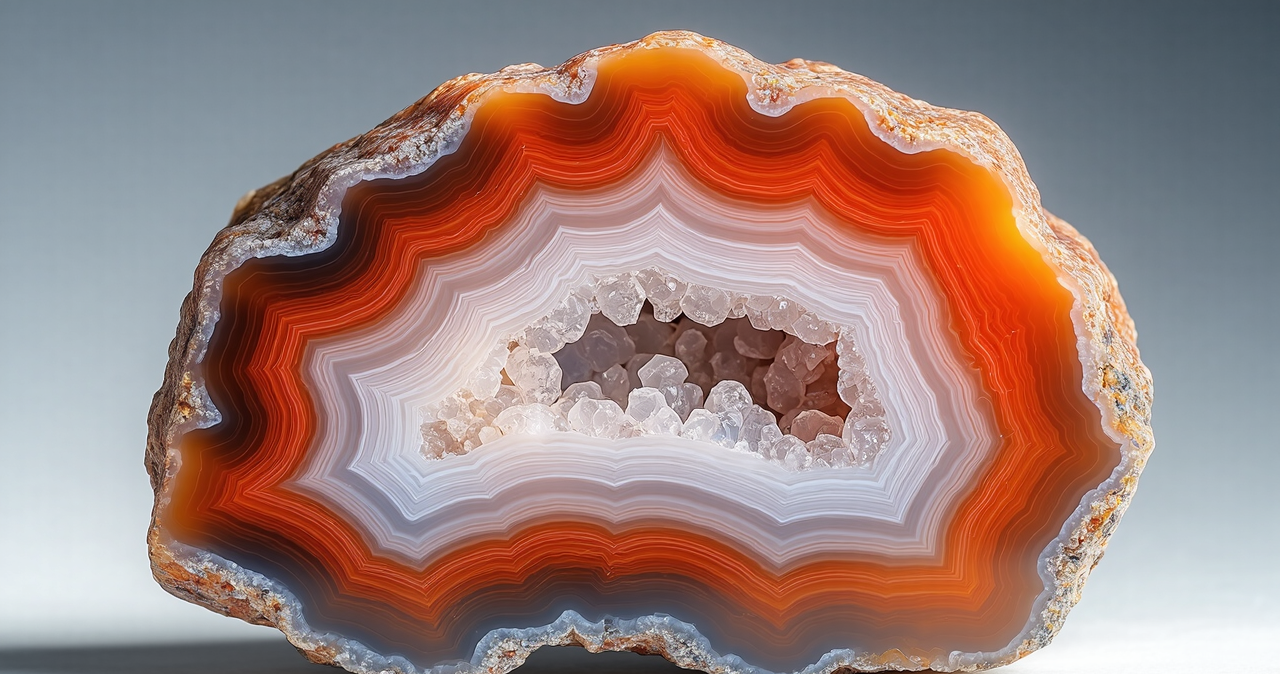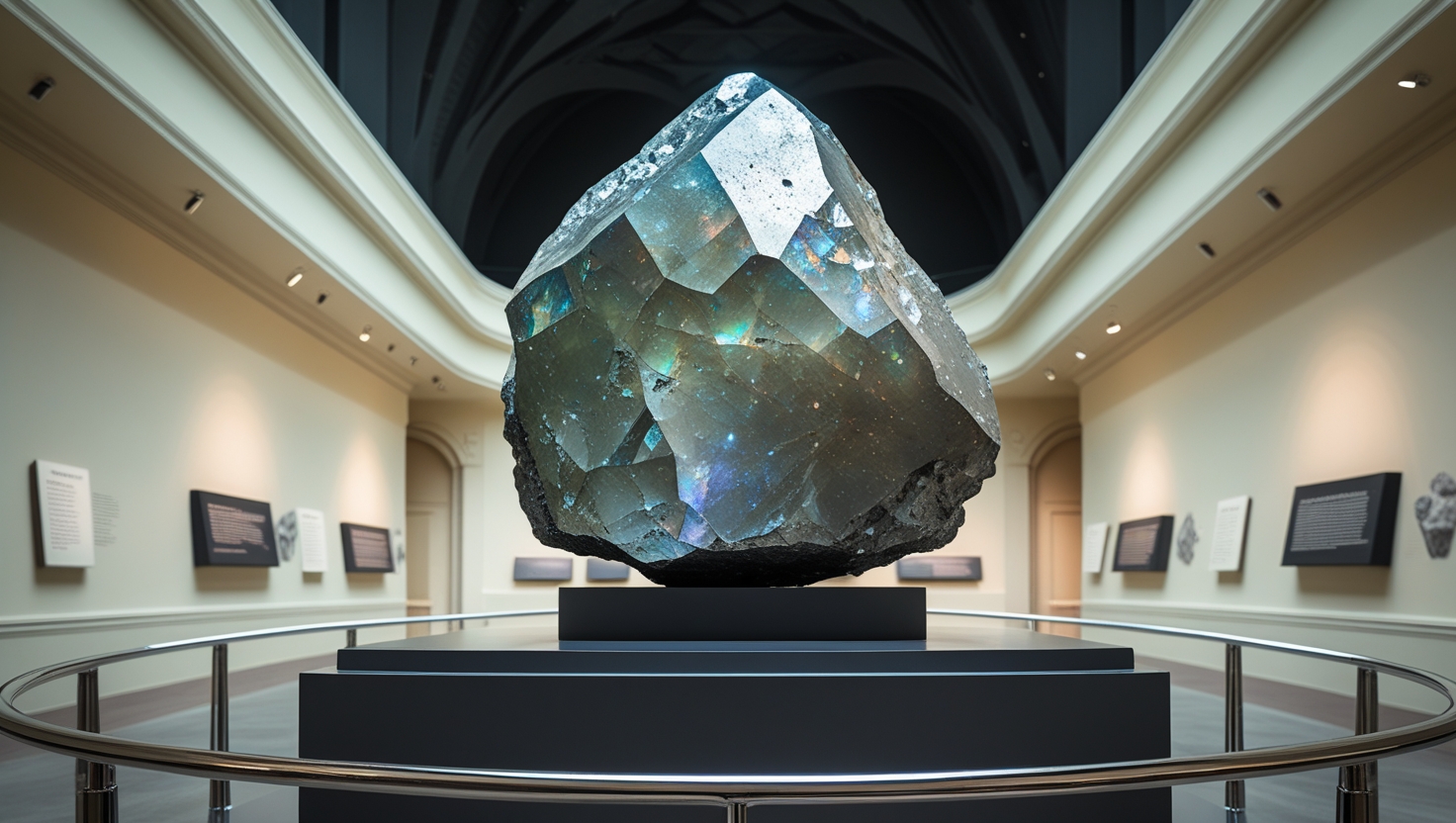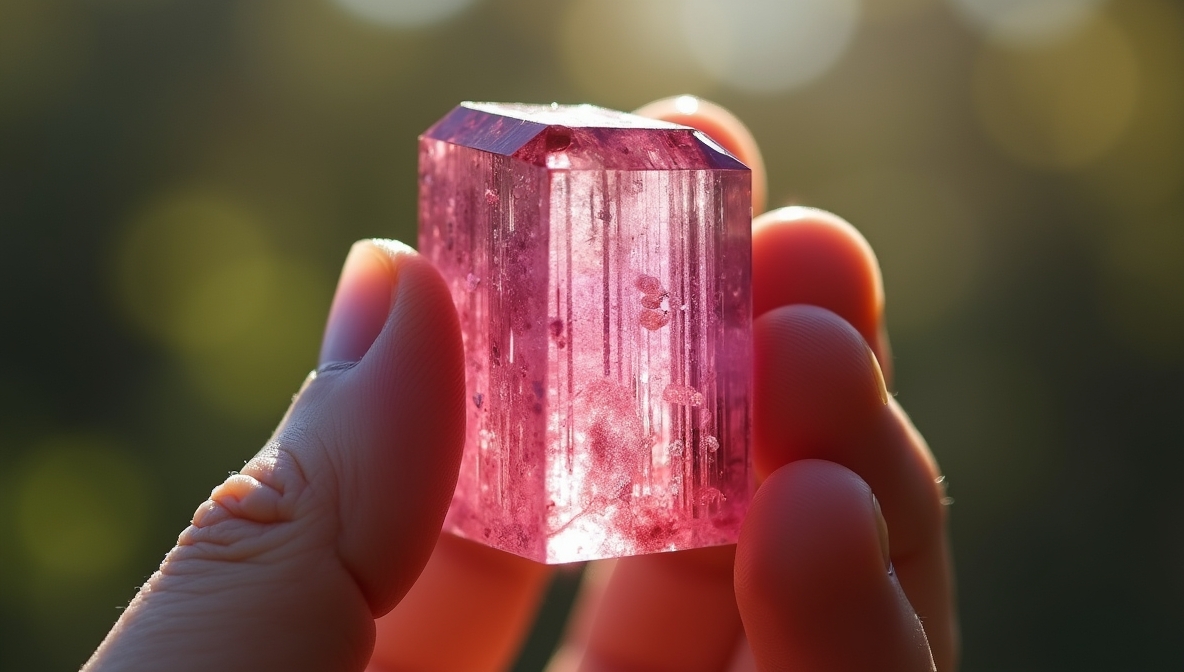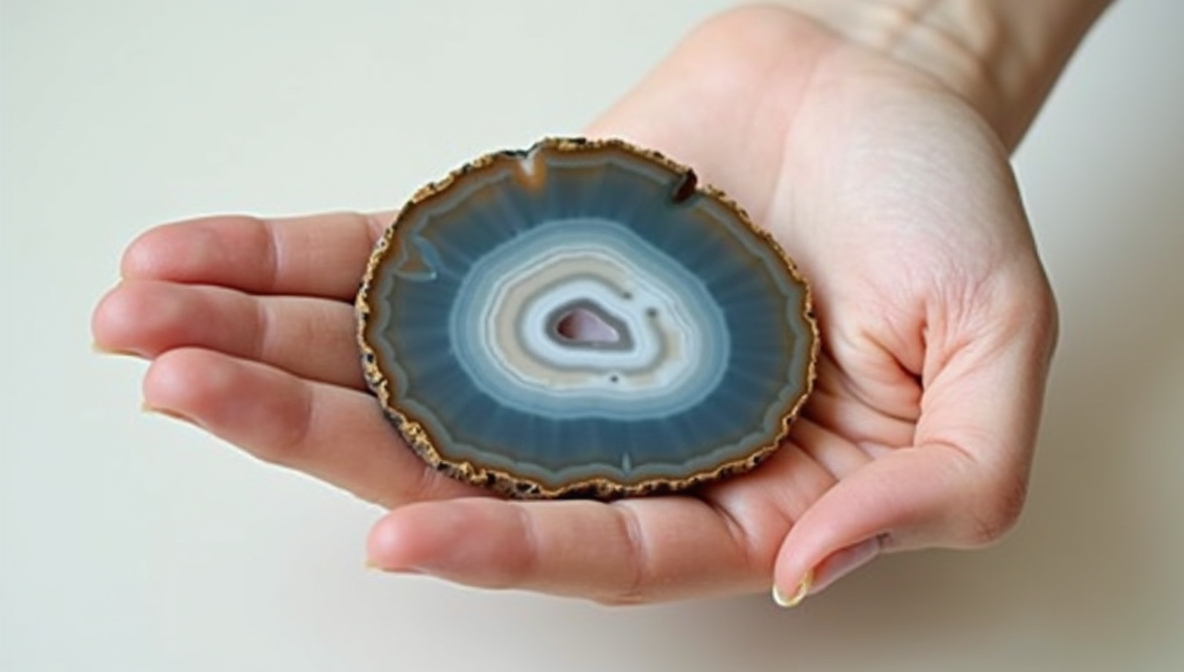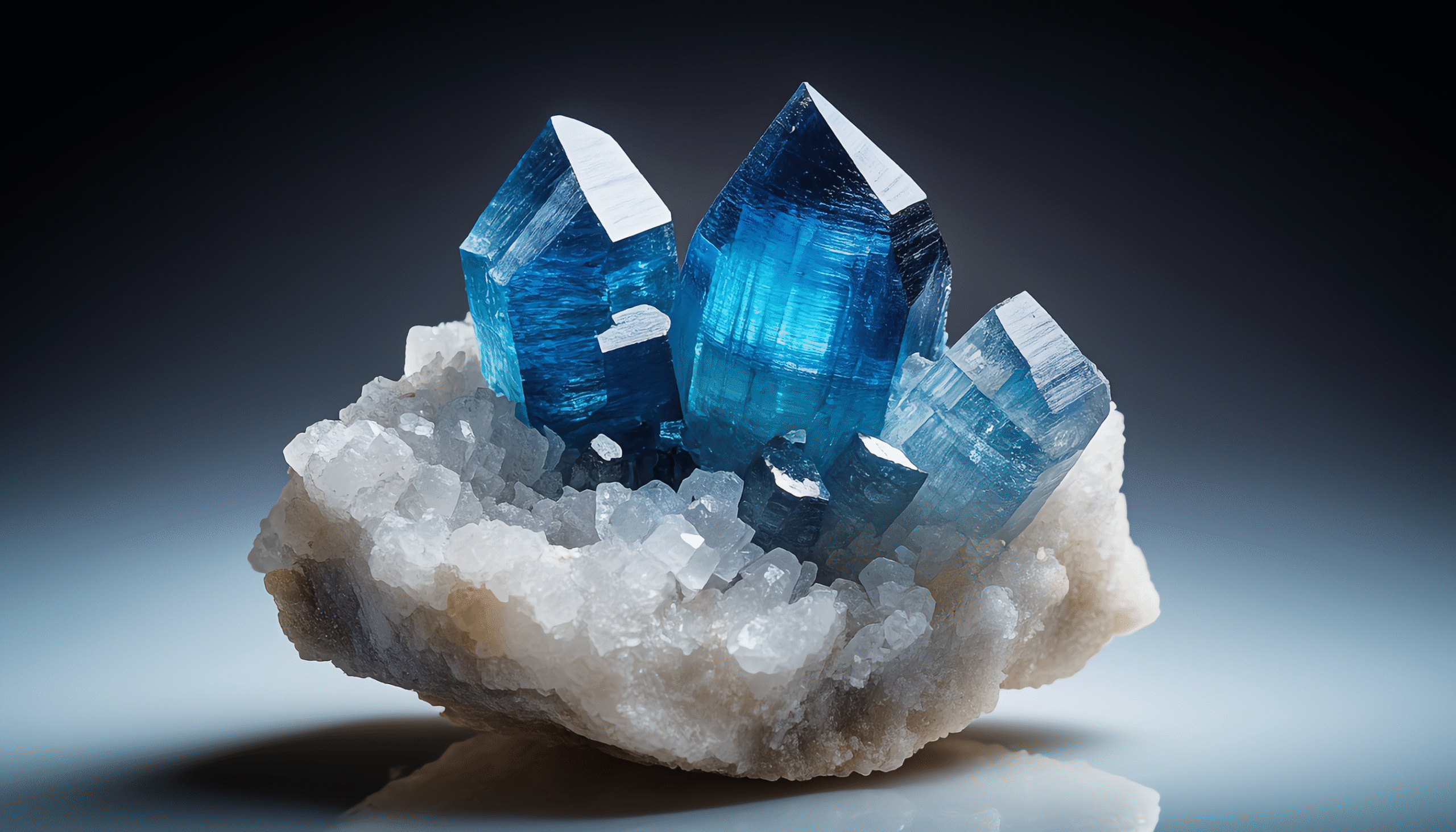See this incredible A Journey into an Agate Geode Slice. Explore its intricate patterns and natural beauty.
There are certain images that transcend simple representation and become gateways to understanding. A photograph of a cut and polished agate geode slice is precisely one such gateway. It is not just a picture of a rock; it is a captured moment of geological time, a collaboration between immense natural forces and human curiosity, a revelation of hidden beauty that speaks volumes about patience, transformation, and the intricate artistry of our planet. Viewed against a plain, light grey background, stripped of distraction, the slice commands our full attention, inviting us to step into its layered world.
The immediate visual impact is stunning. We are confronted with a cross-section, a perfect window into a geological secret previously locked within an unassuming exterior. The shape, though likely irregular around the edges as it was cut from a larger geode, is dominated by the internal structure. The surface presented to us is smooth, reflecting light gently, a testament to the polishing process that has heightened the natural colours and patterns within.
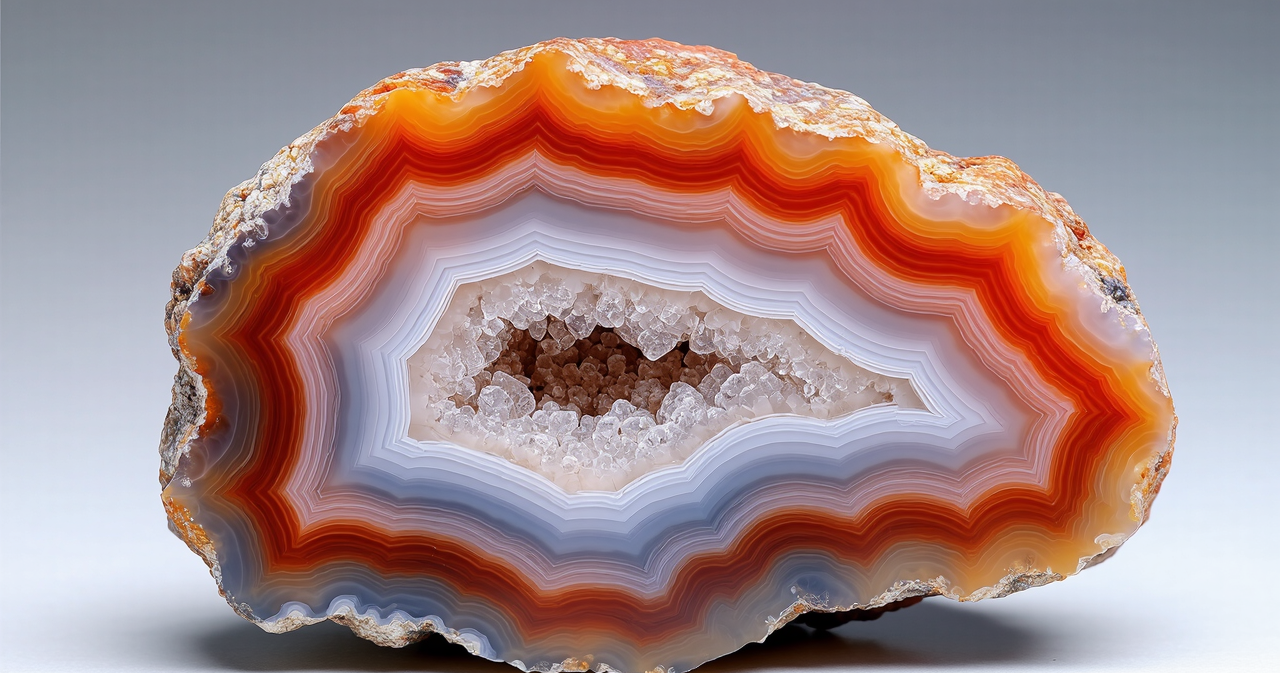
The most striking feature is the series of concentric bands that dominate the bulk of the slice. These aren’t arbitrary lines; they are a geological record, a painted history of the geode’s formation. The description highlights the colours: red, white, and brown. These earthy tones are characteristic of agate, a cryptocrystalline form of silica, primarily chalcedony, with layers formed in sequence. The colours come from trace amounts of minerals present during deposition, often iron oxides creating the reds and browns, while pure silica forms the white or translucent layers.
Looking closely at these bands is like examining the rings of an ancient tree, but on a timescale infinitely vaster. Each band represents a distinct phase of mineral-rich water seeping into a cavity and depositing a thin layer of silica. The patterns are rarely perfectly symmetrical circles; they might undulate, thicken and thin, flow around existing imperfections, or even shift colour dramatically from one layer to the next. This organic, flowing geometry, captured and frozen in solid stone, is mesmerising. It speaks of the slow, patient rhythm of geological processes – water, rich with dissolved minerals, finding its way through rock, slowly, painstakingly, building beauty one microscopic layer at a time. The contrast between the fluid process of formation and the solid, permanent result is a profound aspect of the image.
The colours themselves are significant. Red, white, and brown evoke the earth, soil, and rock. They are grounding colours, connecting us to the very substance of the planet. The layering of these tones creates depth and texture, even on a polished, two-dimensional surface. We can trace the history of the geode’s growth, following a white band that might widen and then narrow, or a red layer that deepens in intensity before giving way to brown. It is a geological fingerprint, unique to this specific geode, shaped by the specific conditions it experienced over thousands or millions of years.
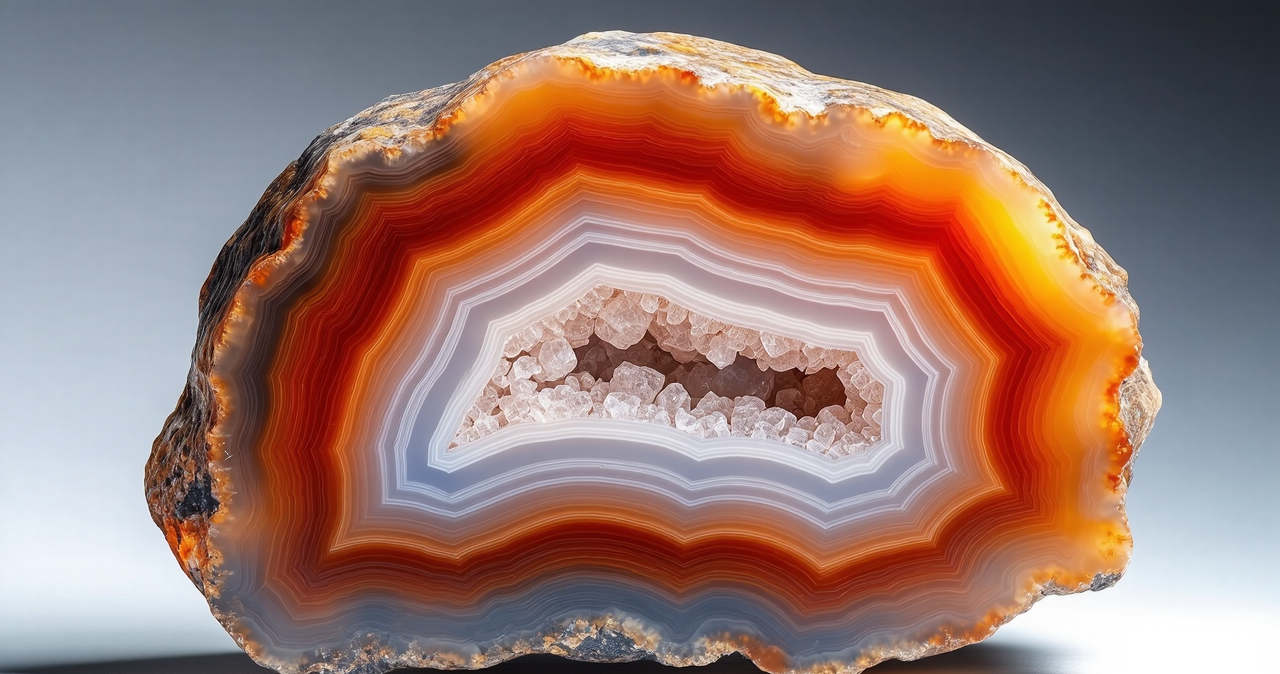
But the agate banding tells only half the story. Moving inward from the layered walls, we encounter the geode’s heart: a hollow cavity. This void is not emptiness in a negative sense, but a space left open during the initial stages of formation, a chamber where a different kind of geological magic could occur. It is the lungs of the geode, the space that allowed for the final act of creation.
And within this cavity, the image reveals the crowning glory: small, sparkling crystals. While the agate layers formed slowly from silica gels depositing on the walls, these crystals grew from mineral-rich solutions that permeated the final void. The description notes they are small and sparkling, strongly suggesting they are quartz crystals (druzy quartz), a common inhabitant of geode cavities. These crystals typically grow inward from the walls, often terminating in sharp, tiny points.
The macro photograph excels here, capturing the way light interacts with these crystal faces. Unlike the smooth, diffuse reflection off the polished agate, the crystals offer sharp, pinpricks of light. Each tiny facet acts like a miniature prism, catching and reflecting light back to the camera, creating a dazzling effect. The centre of the geode, therefore, is not just a hole, but a pocket of light, a glittering treasury hidden within the banded stone. The contrast between the flowing, earthy layers of the agate and the sharp, geometric sparkle of the inner crystals is visually captivating. It’s a journey from the sedimentary calm of deposition to the more dynamic, energetic growth of crystalline structures.
The presence of both the agate banding and the crystal-filled cavity within the same structure is what makes a geode so special. They represent different phases and environments of mineral formation, captured within a single, self-contained unit. The image perfectly showcases this duality – the external layers telling one story, the internal crystals another, both bound together by the geode’s history.
Crucially, this photograph is of a cut and polished slice. This is where the human element enters the narrative. In its natural state, a geode often looks like an ordinary rock, nondescript and rough on the outside. The true beauty is concealed within. The act of cutting – often with a diamond saw – is a process of deliberate revelation, a geologist’s or collector’s gamble on what wonders lie inside. Polishing the cut surface is an act of enhancement. It smooths the rough saw marks, allowing light to penetrate the agate layers more clearly, intensifying the colours and making the patterns pop. The smooth, cool feel of the polished surface is implied by its visual appearance, a tactile counterpoint to the rough, sparkling crystals within the cavity. This slice, therefore, is a collaboration – nature’s raw creation transformed by human skill and curiosity to reveal its hidden heart. The photograph captures this moment of unveiling, presenting the polished truth to the viewer.
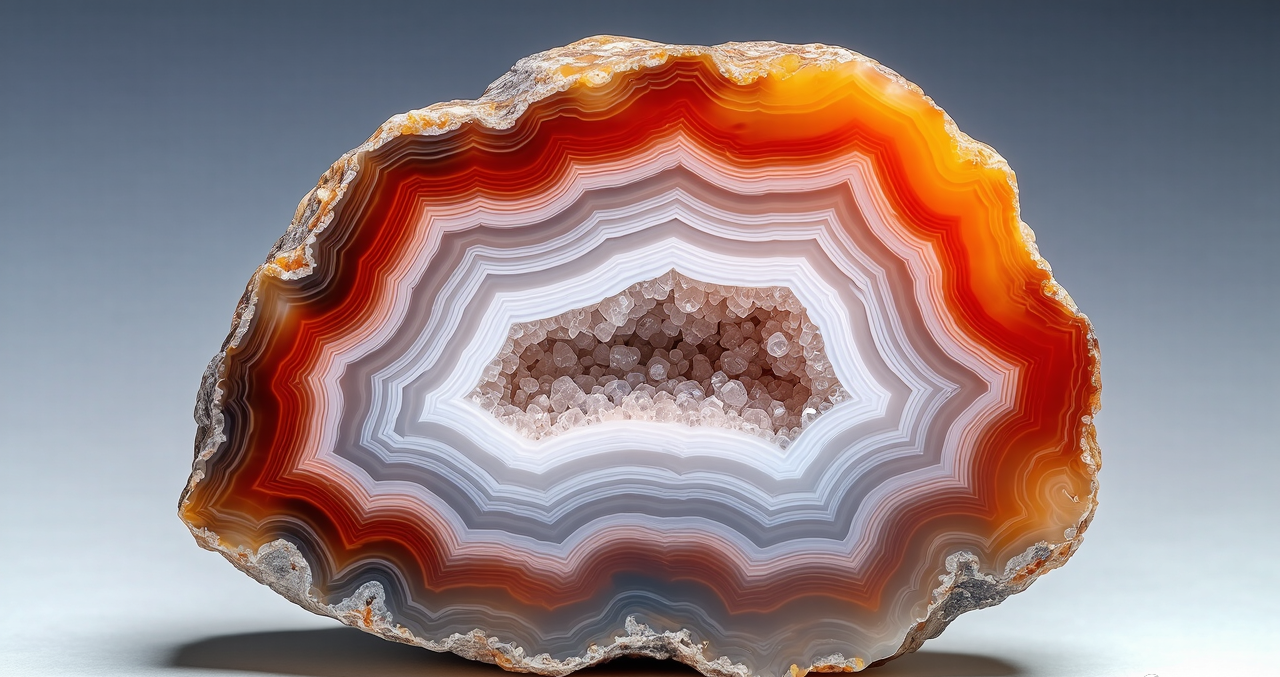
The photograph itself plays a vital role in how we experience this geode slice. The composition, focusing tightly on the slice, isolates it as the sole subject of importance. The sharpness of focus on the details – the intricate banding, the tiny points of the crystals – is paramount in macro photography, allowing us to appreciate the minute features invisible otherwise. The lighting is also critical, specifically engineered to highlight both the depth and translucence of the agate layers and the reflective sparkle of the quartz crystals. The photographer has chosen an angle and light source that best reveal the internal structure and luminosity.
The background choice is particularly significant: a plain, light grey colour. This is not a neutral choice; it’s a deliberate one designed to remove all distractions. A busy or colourful background would compete with the intricate patterns and vibrant heart of the geode. The light grey provides a neutral stage, allowing the eye to focus solely on the subject. It makes the colours of the agate and the light of the crystals stand out in stark relief. It elevates the geode slice from an object in an environment to an object of pure study and aesthetic appreciation, almost as if presented in a museum display or a scientific illustration.
Thinking metaphorically, the agate geode slice is a powerful symbol. It represents hidden beauty, the idea that the most extraordinary things might be contained within the most ordinary exteriors. It speaks to resilience, forming over vast timescales under immense geological pressure. It embodies the journey inward, the progression from the layered outer self to the sparkling, unique core. It can symbolize the potential within us all, waiting to be discovered and revealed. The empty cavity before the crystals formed could be seen as a space of potential, and the crystals as the unique light or essence that eventually fills that space.
In essence, this photograph of a cut and polished agate geode slice is a visual poem about Earth’s slow artistry and hidden wonders. It captures the story of mineral deposition told in swirling bands of red, white, and brown, a record of time solidified. It reveals the secret chamber within, filled not with emptiness, but with a glittering cascade of tiny crystals, a pocket of captured light. It showcases the transformation brought about by human hands, the cutting and polishing that unveils this internal spectacle. And presented against a stark, plain background, the image focuses our gaze entirely on this dialogue between geological process and intrinsic beauty. It is a powerful reminder that beneath the often-unremarkable surface of the world, and perhaps ourselves, lie layers of history and pockets of extraordinary, sparkling light, waiting only to be discovered and revealed. It invites us to look closer, to appreciate the deep time held within a hand-sized stone, and to marvel at the complex, beautiful heart of the Earth.
